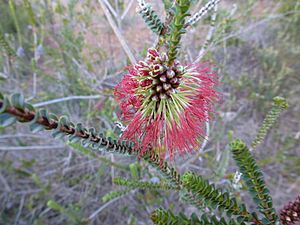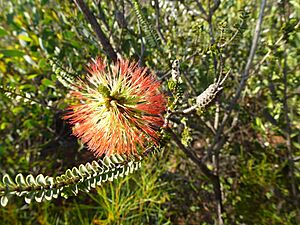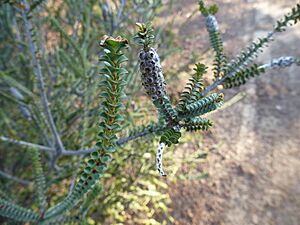Ravensthorpe bottlebrush facts for kids
Quick facts for kids Ravensthorpe bottlebrush |
|
|---|---|
 |
|
| Beaufortia orbifolia leaves and flowers | |
| Scientific classification | |
| Genus: |
Beaufortia (plant)
|
| Species: |
orbifolia
|
| Synonyms | |
|
Melaleuca orbifolia (Muell.) Craven & R.D.Edwards |
|
The Ravensthorpe bottlebrush (scientific name: Beaufortia orbifolia) is a special plant. It belongs to the myrtle family, called Myrtaceae. This plant only grows in the south-west part of Western Australia. It's a shrub that can stand tall or spread out. It has round leaves that are a bit like a dish. These leaves grow close together on the younger stems. The plant also has bright red flowers that look like bottlebrushes. You can find it growing on laterite hills near a town called Ravensthorpe. One cool thing about this plant is its green stamen bundles. The tips of these bundles are red, which helps tell it apart from other similar plants.
Contents
About the Ravensthorpe Bottlebrush
The Ravensthorpe bottlebrush is a shrub that can grow quite tall. It can reach about 3 m (10 ft) high. Sometimes it grows straight up, and other times it spreads out.
Leaves and Stems
The leaves of this plant are arranged in a special way. They grow in pairs, with each pair at right angles to the one below it. This makes them look like they are in four rows along the stems. This is especially true on the younger branches. The leaves are flat or slightly curved like a dish. They are broad and round, measuring about 4.5–6 mm (0.18–0.24 in) long. Each leaf has 5 or 7 small lines, called veins.
Flowers and Fruits
The flowers of the Ravensthorpe bottlebrush are a mix of red and green. They grow in spikes that look like a bottlebrush. These spikes are about 40 mm (2 in) wide and 60 mm (2 in) long. They grow at the ends of the branches. The branches keep growing even after the flowers appear. Each flower has 5 sepals and 5 petals. It also has 5 groups of stamens. Stamens are the parts of a flower that make pollen. Each group of stamens has 3 to 7 individual stamens. The bottom half of these stamen groups is green, and the top half is red. They are joined together for about half their length.
The plant usually flowers from August to January. After the flowers, the plant makes fruits. These fruits are woody capsules. They grow in round or cylinder-shaped clusters.

Discovery and Naming
The Ravensthorpe bottlebrush was first officially described in 1862. A botanist named Ferdinand von Mueller wrote about it. He was a government botanist in Victoria, Australia. He described the plant in his book, Fragmenta phytographiae Australiae. The plant he studied was collected by George Maxwell. George found it on the slopes of East Mount Barren.
The scientific name orbifolia comes from two Latin words. Orbis means "a circle", and folium means "a leaf". This name describes the plant's round leaves.
Where It Grows
The Ravensthorpe bottlebrush mostly grows near Ravensthorpe. This area is in the south-west of Western Australia. It can be found in different natural regions, including the Avon Wheatbelt, Coolgardie, Esperance Plains, and Mallee. It usually grows in soils that come from laterite or granite rocks. You can often see it on stony plains.
Conservation Status
The Western Australian Government's Department of Parks and Wildlife says this plant is "not threatened". This means it is not currently in danger of disappearing.


